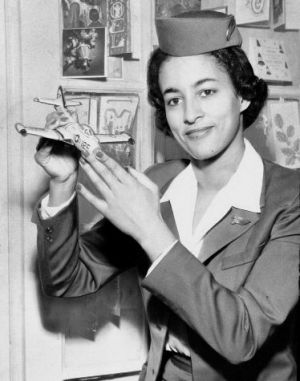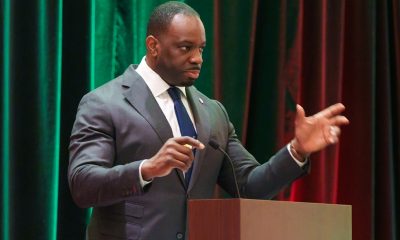Black History
Ruth Carol Taylor: Breaking the Sky-High Ceiling
During a 1997 interview with Jet magazine, Taylor described herself as a “blacktivist,” and admitted that she had “no long-term career aspirations as a flight attendant but only wanted to break the color barrier.”

It was the 1950s. The United States had been dubbed “the world’s strongest military power.” The economy was booming. Jobs were overflowing; housing was plentiful. But for Black Americans, racism was on fire, the Civil Rights Movement was gaining speed, and the best-paying jobs were for whites.
The airlines were no exception.
None of this stopped Ruth Carol Taylor (1931–), a journalist and nurse from New York City, from submitting her application to Trans World Airlines (TWA) for the position of airline stewardess (known today as flight attendants).
Her application was rejected almost immediately because she “did not meet the airline’s physical standards.”
Stewardesses, at the time, were selected because of their physical attractiveness and height/weight conformity. But the decision made to reject Taylor’s application was racially motivated. She filed a discrimination complaint with the New York State Commission and approached other airlines offering the position.
Mohawk Airlines, a regional passenger airline operating in the Mid-Atlantic region of the U.S., mainly in New York and Pennsylvania, began advertising open positions for stewardesses. The company also announced the open recruitment of Black women. More than 800 applied, and Taylor became one of the new hires. This made her the first African-American airline flight attendant in the US. It was 1958.
When asked about being the only Black hire, Taylor said that she believes it was “due to nearly white-passing skin and features.” She completed her training in early 1959 and was ready to take on her first flight.
After a few months, TWA, threatened by the lawsuit, brought its first Black stewardess onboard: Margaret Grant.
A short time later though, Taylor was grounded. She was let go from Mohawk on another discriminatory practice: she met and married Rex Legall and was forced to resign from her position. A ban against stewardesses being married or pregnant was not uncommon at that time.
Due to the decisive court case of Diaz vs. Pan Am., the no-marriage rule was eliminated throughout the US airline industry by the 1980s.
Taylor and Legall traveled and lived abroad for a few years. After their divorce, Taylor, in 1977, returned to New York City and nursing.
Best known for breaking the color barrier in the airline industry, Taylor was also an activist for minority and women’s rights. In 1963, she covered the March on Washington as a journalist for a British magazine, Flamingo.
By 1977, she began to focus more on her work as an activist. In 1982, she cofounded the Institute for Inter-Racial Harmony Inc. There she developed testing designed to measure racial bias in educational, commercial, and social settings.
During a 1997 interview with Jet magazine, Taylor described herself as a “blacktivist,” and admitted that she had “no long-term career aspirations as a flight attendant but only wanted to break the color barrier.”
Today she lives in Brooklyn.
Activism
Oakland Post: Week of April 24 – 30, 2024
The printed Weekly Edition of the Oakland Post: Week of April 24 – 30, 2024

To enlarge your view of this issue, use the slider, magnifying glass icon or full page icon in the lower right corner of the browser window. ![]()
Activism
Oakland Post: Week of April 17 – 23, 2024
The printed Weekly Edition of the Oakland Post: Week of April 17 – 23, 2024

To enlarge your view of this issue, use the slider, magnifying glass icon or full page icon in the lower right corner of the browser window. ![]()
Black History
Matthew Henson: Explorer Extraordinaire
Matthew Henson, a trailblazing explorer who overcame countless obstacles to leave an incredible mark on history. Born on August 8, 1866, in Charles County, Maryland, his journey is a testament to the power of determination and the spirit of adventure.

By Tamara Shiloh
Matthew Henson, a trailblazing explorer who overcame countless obstacles to leave an incredible mark on history. Born on August 8, 1866, in Charles County, Maryland, his journey is a testament to the power of determination and the spirit of adventure.
Henson’s life began amidst the backdrop of post-Civil War America, where opportunities for African Americans were scarce. From a young age, he possessed an insatiable curiosity about the world beyond his small town. At the age of 12, he embarked on a journey that would change the course of his life forever when he joined a merchant ship as a cabin boy.
His most famous expedition was his journey to the Arctic with renowned explorer Robert E. Peary. In 1887, Henson joined Peary’s crew as a seaman and quickly proved himself to be invaluable with his skills as a navigator and craftsman. Over the course of several expeditions, Matthew endured extreme cold, treacherous terrain, and grueling conditions as he and Peary sought to reach the elusive North Pole.
In 1908–09, Peary set out on his eighth attempt to reach the North Pole. It was a big expedition, with Peary planning to leave supplies along the way. When he and Henson boarded their ship, the Roosevelt, leaving Greenland on August 18, 1909, they were joined by a large group. This included 22 Inuit men, 17 Inuit women, 10 children, 246 dogs, 70 tons of whale meat, blubber from 50 walruses, hunting gear, and tons of coal.
In February, Henson and Peary left their anchored ship at Ellesmere Island’s Cape Sheridan, along with the Inuit men and 130 dogs. They worked together to set up a trail and supplies along the way to the Pole.
Peary picked Henson and four Inuit people to join him in the final push to the Pole. However, before they reached their destination, Peary couldn’t walk anymore and had to ride in a dog sled. He sent Henson ahead to scout the way. In a later interview with a newspaper, Henson recalled being in the lead and realizing they had gone too far. The group turned back, and Henson noticed his footprints helped guide them to their destination. At that location, Henson planted the American flag.
Henson’s legacy extends far beyond his expeditions to the Arctic. He shattered racial barriers in the world of exploration and inspired countless individuals, regardless of race, to dream big and pursue their passions. In 1937, he was finally recognized for his achievements when he was inducted into The Explorers Club, an organization dedicated to promoting scientific exploration and field research.
Matthew Henson died in the Bronx, New York, on March 9, 1955, at the age of 88.
-

 Activism4 weeks ago
Activism4 weeks agoOakland Post: Week of March 27 – April 2, 2024
-

 #NNPA BlackPress4 weeks ago
#NNPA BlackPress4 weeks agoBeloved Actor and Activist Louis Cameron Gossett Jr. Dies at 87
-

 Community2 weeks ago
Community2 weeks agoFinancial Assistance Bill for Descendants of Enslaved Persons to Help Them Purchase, Own, or Maintain a Home
-

 Activism3 weeks ago
Activism3 weeks agoOakland Post: Week of April 3 – 6, 2024
-

 Business2 weeks ago
Business2 weeks agoV.P. Kamala Harris: Americans With Criminal Records Will Soon Be Eligible for SBA Loans
-

 Activism2 weeks ago
Activism2 weeks agoOakland Post: Week of April 10 – 16, 2024
-

 Community2 weeks ago
Community2 weeks agoAG Bonta Says Oakland School Leaders Should Comply with State Laws to Avoid ‘Disparate Harm’ When Closing or Merging Schools
-

 Community1 week ago
Community1 week agoOakland WNBA Player to be Inducted Into Hall of Fame






















































